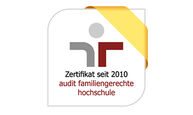How do I participate in a Zoom meeting?
There is a link for each Zoom meeting, which you can get from your lecturer or find in your Moodle course. You can also use Zoom for study groups, student projects, or tutorials. As a participant, you will then receive the link from the person setting up the Zoom meeting. You can read how to set up a Zoom meeting in the column on the right.
As a participant, click on the link and confirm with "Open Link" when the "Start Application" window opens. If you are using Zoom for the first time, you will first be directed to install the Zoom app. If Zoom participation is password protected, you will now be asked for the password - enter the password and confirm by clicking "Join the meeting". In the following window, choose whether you want to join the meeting with or without a picture. Usually, you do not need to register with Zoom to join a meeting.
I have signed up for Zoom before, how do I sign up now with my university account?
Log in using your university account via the URL https://hs-niederrhein.zoom.us. In other places, e.g. on the Zoom website or in the app, please select "Log in via SSO" and enter the organizational domain "hs-niederrhein". You will then be redirected to the university's login page and can log in with your university ID. Direct login with email address and password is not possible.
Can I now transfer my Zoom account, which I registered with my private email address, to the university email address?
No, since you must log in using the above URL, no transfer is possible.
When I click on the link, I am supposed to download a file, what do I do?
Depending on your configuration, to join a Zoom meeting for the first time, you will need to download a file that includes the Zoom app. So, confirm the download and open the file by double-clicking on it. Then follow the steps as explained in the question above.
Where can I adjust the picture and sound?
At the bottom of the video window you will find various icons. On the left side of the bar, you can use the audio or video icon to turn your sound and image on and off. Both icons have a small upward pointing arrow that you can use to access more options to edit your video and audio settings.
Is it possible to chat or ask questions in writing?
Yes, in the lower icon bar you will find the icon "Chat" in the middle with which you can open the chat window.
The other participants do not hear me or hear me poorly, what can I do?
If you join a meeting and have not selected ''Always participate in audio via computer'', you will see a prompt where you can click on ''Test computer microphone and speakers'' to enter your audio settings. If you are already in a meeting, click on the upward pointing arrow next to "Mute" to enter your audio settings. In the settings, you can now test your speaker and microphone. If the audio quality of your internal microphone is not sufficient, use a headset if necessary. If you cannot be heard at all, check that your microphone is muted.
Can I join a meeting without installing the app?
Yes, when you click the link provided for the Zoom meeting, you will be redirected to the Zoom website. You will be prompted to download a file there, if you don't want to or can't, click the "join via your browser" link highlighted in blue. Enter your surname and join the meeting.
Where can I get the desktop client? Where can I get the mobile app?
You can get the mobile app as usual in the app stores of Google (Play Store) or Apple. You can download the desktop client for Windows, Mac and Linux here: https: //zoom.us/download.
Is there an option to open a test meeting beforehand?
Yes, you can open a test meeting at https://www.zoom.us/test. To join the test meeting, proceed as described in question 1. If you want to invite additional participants, click on the small exclamation mark in the upper left corner of the window. Here you can now view and send the "invitation link".
How do I use a virtual background?
For successful teaching education, an open exchange between lecturers and learners is beneficial. In digital lectures via Zoom, it is therefore often more convenient if lecturers can also see the participants of the lecture, because their reactions and expressions can influence the course of the lecture. However, if you as a participant do not want to give a glimpse of your private premises, it is advisable to use a virtual background. With the virtual background function you can show a picture as your background during a zoom meeting. If you want to set up a background before a meeting starts, do the following: Start the Zoom application and click on "Settings" (gear icon). Then select the "Virtual background" tab and pick a background. Alternatively, you can upload your own background. If you are already in the meeting and want to set up a virtual background afterwards, click on the upward pointing arrow next to "Start/End Video" and then select the "Select Virtual Background" option.
What can I do if the camera does not work or is not recognized?
Test your video before a meeting: in Zoom, click your profile picture and then click "Settings." Then select the "Video" option. You will now be shown the preview of your camera and you can check your settings, if necessary also select a different camera. If you are already in the meeting, click on the upward pointing arrow next to "End Video" and select "Video Settings". If your camera still does not work, it is recommended that you update to the latest version or reinstall the application.
How do I set up a profile picture?
In the event of connection problems, it may exceptionally make sense to dispense with the video in order to reduce bandwidth. Alternatively, you can set up a profile picture in Zoom in these cases. You have the option to set up a profile picture if you have created a Zoom account. To access your Zoom profile, log in to the Zoom web portal and click Profile. Click "Modify" under the profile picture icon to add your profile picture. You can also delete your profile picture by clicking on "Delete"
--
If you have further questionsabout using Zoom Meetings, visit the Zoom Help Center, which provides detailed information on various topics:
https://support.zoom.us/hc/de















